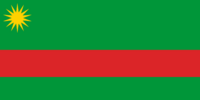Khirmania: Difference between revisions
Jump to navigation
Jump to search
No edit summary |
No edit summary |
||
| Line 60: | Line 60: | ||
==Parliament== | ==Parliament== | ||
The Khirmanian Parliament is the unicameral legislative branch of the Government of Khirmania. | The Khirmanian Parliament is the unicameral legislative branch of the Government of Khirmania. Members of parliament are alected to a | ||
==Law== | ==Law== | ||
Revision as of 03:41, 29 June 2023
The Holy State of Khirmania | |
|---|---|
|
Flag | |
| Motto: May the Gods bless us | |
| Capital | Mukarda |
| Official languages | Khirmani, Common |
| Ethnic groups |
|
| Religion |
|
| Demonym(s) | Khirmanian |
| Government | Unitary theocratic absolute elective monarchy |
• Lakan | Duwo II |
| Population | |
• 2022 estimate | 18.7 million |
| Currency | Khirmanian Dollar |
Khirmania, officially the Holy State of Khirmania, is a sovereign nation located in Thrismari and is bordered by Salamat to the southwest and Ouardania to the north.
History
Pre-history
13th century to Riamese colonisation
The Great War
Independent Nation and Mamud Khadir
21st Century
Geography
Climate
Biodiversity
Government and Politics
Lakan
The Lakan is the head of state and highest religious official of Khirmania who holds absolute power.
Parliament
The Khirmanian Parliament is the unicameral legislative branch of the Government of Khirmania. Members of parliament are alected to a
Law
Military
Economy
Khirmania is a upper middle developing socialist mixed economy. For most of its history, the nation was mostly an agrarian society. It experienced rapid economic and industrial growth that started in the early 1960s up until the start of the Salamati-Khirmanian war.
